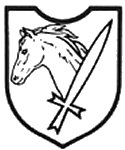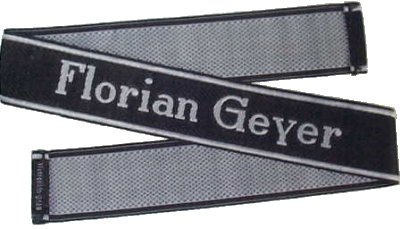
The 8. SS-Kavallerie-Division Florian Geyer was formed as SS-Kavallerie-Division in 1942 when SS-Kavallerie-Brigade was upgraded and about 9.000 Romanian volksdeutsche drafted into the unit.
In March 1944 the SS-Kavallerie Regiment 17 was transferred to the forming 22. SS-Freiwilligen-Kavallerie-Division.
It saw actions against partisans in the east (Briansk and Vjasma among other places) as well as in the Balkans before being transferred to Budapest where it was destroyed when the city fell to the Red Army.
General der Kavallerie Gustav Harteneck, commander of I Kavallerie-korps, later wrote:While the Corps was still in the process of being transferred, we were once again ordered to take up stationary positions, to our great disappointment. The cavalry divisions of the Waffen-SS were fighting in the metropolis of Budapest. Every cavalryman knows that no good could come of that, and, as it turned out, nothing did. The SS divisions were encircled … My Cavalry Corps launched a night attack in an attempt to relieve them, but it was too late, and the Russian forces were too powerful. Although we managed to fight out way to the city limits, only 100 or so cavalrymen, under the command of the famous rider Staff Colonel von Mitzlaff, were able to break through to us. The subsequent battles, in the course of which my Corps was under the command of 6th SS Panzer Army, might have turned out quite differently had the two SS cavalry divisions been deployed to full advantage as cavalry divisions, instead of being ordered to hold Budapest. (1)
Lineage
SS-Kavallerie-Brigade (Aug 1941 – June 1942)
SS-Kavallerie-Division (June 1942 – Oct 1942)
8. SS-Kavallerie-Division (Oct 1942 – Mar 1944)
8. SS-Kavallerie-Division Florian Geyer (Mar 1944 – May 1945)
Commanders
SS-Brigadeführer Gustav Lombard (? Mar 1942 – ? Apr 1942)
SS-Gruppenführer Hermann Fegelein (? Apr 1942 – ? Aug 1942)
SS-Obergruppenführer Willi Bittrich (? Aug 1942 – 15 Feb 1943)
SS-Brigadeführer Fritz Freitag (15 Feb 1943 – 20 Apr 1943)
SS-Brigadeführer Gustav Lombard (20 Apr 1943 – 14 May 1943)
SS-Gruppenführer Hermann Fegelein (14 May 1943 – 13 Sep 1943)
SS-Gruppenführer Bruno Streckenbach (13 Sep 1943 – 22 Jan 1943)
SS-Gruppenführer Herman Fegelein (22 Jan 1943 – 1 Jan 1944)
SS-Gruppenführer Bruno Streckenbach (1 Jan 1944 – 14 Apr 1944)
SS-Brigadeführer Gustav Lombard (14 Apr 1944 – 1 July 1944)
SS-Brigadeführer Joachim Rumohr (1 July 1944 – 11 Feb 1945) (2)
Chief of Staff
SS-Sturmbannführer E von Elfenau (19 Sep 1942 – 8 Apr 1943)
SS-Sturmbannführer Hans Diergarten (8 Apr 1943 – 21 Aug 1944)
Oberstleutnant Sven von Mitzlaff (22 Aug 1944 – ? 1945)
Quartermaster
SS-Hauptsturmführer Gerhard Petter (? – Apr 1943)
SS-Hauptsturmführer Albert Schatzmann (? 1943 – 22 Oct 1943)
SS-Obersturmführer Erich Streubel (22 Oct 1943 – ? 1944)
SS-Hauptsturmführer Albert Schatzmann (1 July 1944 – ?)
Area of operations
Poland (Mar 1942 – Sep 1942)
Eastern front, southern & central sectors (Sep 1942 – Dec 1943)
Croatia, Czechoslovakia & Poland (Dec 1943 – Apr 1944)
Hungary (Apr 1944 – Feb 1945)
Manpower strength
Dec 1942 10.879
Dec 1943 9.326
June 1944 12.895
Dec 1944 13.000
Honor titles
Florian Geyer (ca. 1490 – 1525) was a Franconian knight and devout follower of Martin Luther who is best known as a peasant leader during the Bauernkrieg (peasant’s war) of 1522 – 1525. Initially serving as a Landsknecht leader with the Swabian Alliance, he fought Duke Ulrich of Wurttemberg and Götz von Berlichingen (After whom the 17th SS Division was named!) before entering the services of Grand Master Albrecht of Prussia, later leading the rebellious peasants with the goal of reforming the Reich by abolishing the privileges of church and nobility and empowering the citizens and peasants. He was slain by a servant of his brother-in-law Wilhelm von Grumbach in Rimpar near Würzburg. Geyer’s leadership of peasants and his opposition to the Catholic Church made him an appropriate symbolic figure for the Nazis and particularly the SS, whose ideology was also anti-church and centered heavily around the ideas of “blood and soil” and the significance of German peasantry. There is also a 19th-century song about Geyer, which must have appealed to those responsible for choosing the division’s name, as its text starts with the words “Wir sind des Geyers schwarzer Haufen…” (“We are Geyer’s black-clad troops…”) – while Waffen-SS troops (apart from tank crews) did not wear black uniforms anymore at the time the division was formed, the SS was still universally identified as the “black corps”. (And still made use of the color black on its flags, collar patches, cap bands and shoulder board underlays, to name just a few examples.)
Holders of high awards
[includes SS-Kavallerie-Brigade]
Holders of the Close Combat Clasp in Gold (4)
– Boosfeld, Joachim, 21.02.1945, SS-Obersturmführer, Chef 4./SS-Kav.Rgt. 16
– Buck, Friedrich, 27.01.1945, SS-Oberscharführer, Führer 5./SS-Kav.Rgt. 15
– Maringgele, Hermann, 21.02.1945, SS-Hauptscharführer, Zugführer i. d. 2./SS-Kav.Rgt. 15
– Phoenix, Harry, 21.02.1945, SS-Hauptsturmführer, Kdr II./SS-Art.Rgt. 8 [often incorrectly listed as Phönix]
Holders of the Commendation Certificate of the Commander-in-Chief of the Army (1)
– Diergarten, Hans, 07.11.1943 (2457), SS-Sturmbannführer, Fhr. einer Kampfgruppe / Ia SS-Kav.Div.
Holders of the German Cross in Gold (61)
Holders of the Honor Roll Clasp of the Heer (1)
– Heuer, Werner, 17.12.1944, SS-Obersturmführer d.R., 1./SS-Kav.Rgt. 15
Holders of the Knight’s Cross (25)
Order of battle (summer 1943)
SS-Kavallerie-Regiment 1
SS-Kavallerie-Regiment 2
SS-Kavallerie-Regiment 3
SS-Artillerie-Regiment
SS-Radfahr-Abteilung
SS-Panzerjäger-Abteilung
SS-Flak-Abteilung
SS-Nachrichten-Abteilung
SS-Pionier-Bataillon
SS-Sturmgeschütz-Batterie
SS-Feldersatz-Bataillon
Order of battle (fall 1943)
SS-Kavallerie-Regiment 15
SS-Kavallerie-Regiment 16
SS-Kavallerie-Regiment 17
SS-Kavallerie-Regiment 18
SS-Artillerie-Regiment 8
SS-Panzerjäger-Abteilung 8
SS-Aufklarungs-Abteilung 8
SS-Nachrichten-Abteilung 8
SS-Pionier-Bataillon 8
SS-Flak-Abteilung 8
SS-Feldersatz-Bataillon 8
SS-Sturmgeschütz-Abteilung 8
SS-Radfahr-Aufklärungs-Abteilung 8
SS-Ski-Battalion
SS-Verwaltungsstruppen 8
SS-Sanitäts-Abteilung 8
SS-Veterinär-Kompanie 8
SS-Feldpostamt
SS-Kriegsberichter-Zug (mot) 8
SS-Feldgendarmerie-Trupp 8
SS-Krankenkraftwagenzug
Notable members
Eberhard von Künsberg (Commander of the infamous Sonderkommando Ribbentrop)
Max Schachner (Credited with destroying 24 Soviet tanks during 16 October 1943)
Bruno Streckenbach (SS-Gruppenführer, head of Einsatzgruppe I during the invasion of Poland, head of Amtsgruppe I of Reichssicherheitshauptamt (RSHA) 1940-1942)
Officers serving in the Einsatzgruppen and Concentration Camps
Concentration Camps 28
Einsatzgruppen 1
(includes officers serving in the Einsatzgruppen or Concentration Camps either prior to or after service in this unit)
Insignia
The “Florian Geyer” cuff title was authorized for this unit.
Until the “Florian Geyer” honor title was given to the unit, a “SS-Kavallerie-Division” cuff title is known to have been used unofficially.

Footnotes
1. “Axis Cavalry in World War II” by Dr Jeffrey T. Fowler page 21.
2. Joachim Rumohr committed suicide 11 February 1945 following the failure of the breakout from Budapest.
Sources used
John R. Angolia – Cloth insignia of the SS
Roger James Bender & Hugh Page Taylor – Uniforms, Organization and History of the Waffen-SS, vol 3
Georges M. Croisier – Waffen-SS (PDF)
Dr Jeffrey T. Fowler – Axis Cavalry in World War II
Terry Goldsworthy – Valhalla’s Warriors: A history of the Waffen-SS on the Eastern Front 1941-1945
Steve Kane – Waffen-SS Forces in the Balkans: A checklist (in World War II Journal, Vol 7)
Dr. K-G Klietmann – Die Waffen-SS: eine Dokumentation
Richard Landwehr – Budapest: The Stalingrad of the Waffen-SS
Kurt Mehner – Die Waffen-SS und Polizei 1939-1945
Martin Månsson – Heinrich Himmler: A photographic chronicle of Hitler’s Reichsführer-SS
Marc J. Rikmenspoel – Waffen-SS Encyclopedia
George H. Stein – The Waffen-SS: Hitler’s Elite Guard at War 1939-1945
John E. Strandberg – Horsepower: The use of horses by the German armed forces during World War II (in Military Advisor Vol 21, No 4)
Gordon Williamson & Thomas McGuirl – German military cuffbands 1784-present
Gordon Williamson – German Security and Police Soldier 1939-45
Gordon Williamson – The Waffen-SS: 6. to 10. Divisions
Mark C. Yerger – German Cross in Gold Holders of the SS and Police, Volume 4: Cavalry Brigade & Divisions
Mark C. Yerger – Waffen-SS Commanders: The Army, corps and divisional leaders of a legend (2 vol)
Reference material on this unit
Massimiliano Afiero – 8. SS-Kavallerie-Division Florian Geyer
Hanns Bayer – Die Kavallerie der Waffen-SS (Selbstverlag)
Hanns Bayer – Die Kavallerie-Divisionen der Waffen-SS im Bild (Munin Verlag)
Ludwig Fürbaß – Krieg kann man nicht spielen: Lebensjahre zwischen 1923 bis 1950
Richard Landwehr – Budapest: The Stalingrad of the Waffen-SS
Rolf Michaelis – Die Kavallerie-Divisionen der Waffen-SS
Charles Trang – The Florian Geyer Division – La Division Florian Geyer
Hans-Otto Wachter – Divisionsgeschichte der 8. SS-Kavallerie-Division “Florian Geyer” (40+ volume series)
Paul J. Wilson – Himmlers Cavalry: The Equestrian SS 1930 – 1945
Mark C. Yerger – German Cross in Gold: Holders of the SS and Police, Volume 4, Cavalry Brigade and Divisions


